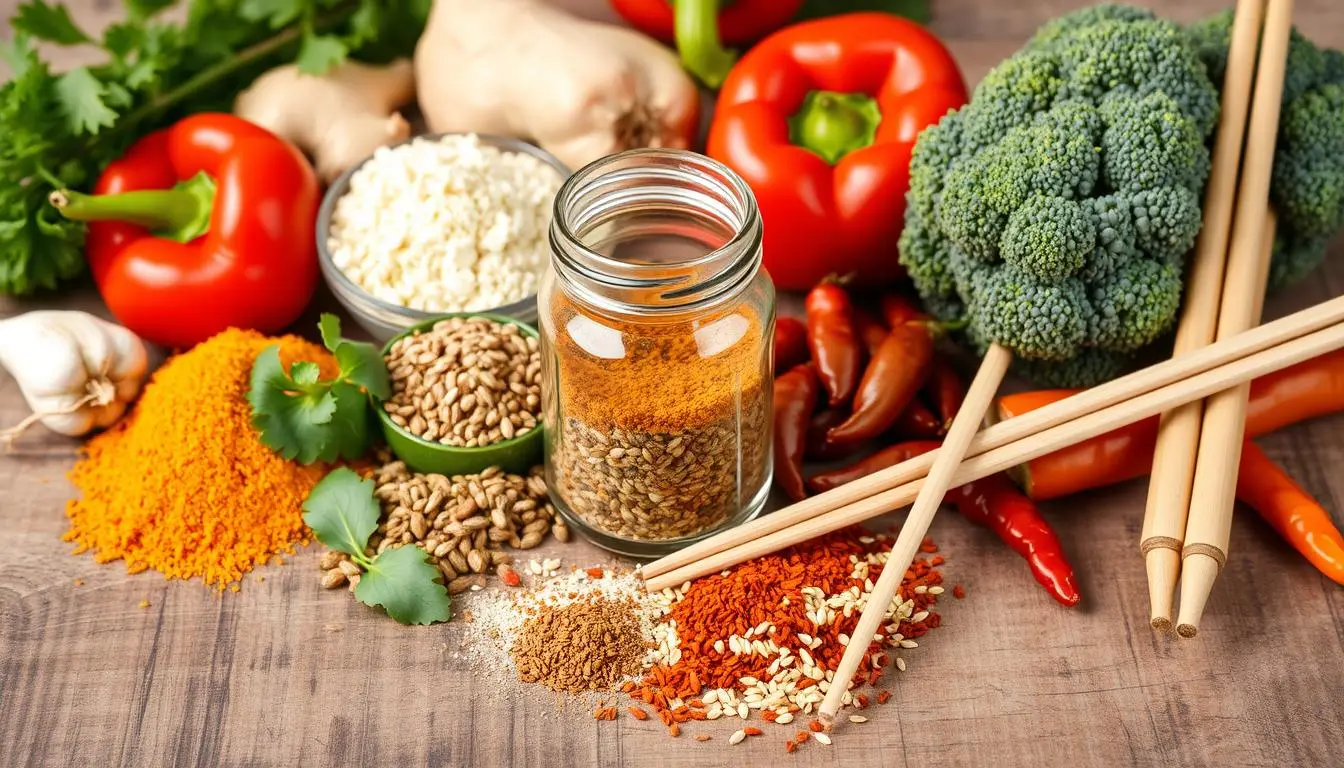Hey there, fellow foodies! I’m excited to share a secret with you. You can make your own stir fry seasoning in just a few minutes. Just think of using garlic, ginger, and chili flakes for that extra kick. This homemade seasoning will make your meals unforgettable.
So, are you ready to say goodbye to store-bought spices? Let’s create your own signature blend together!
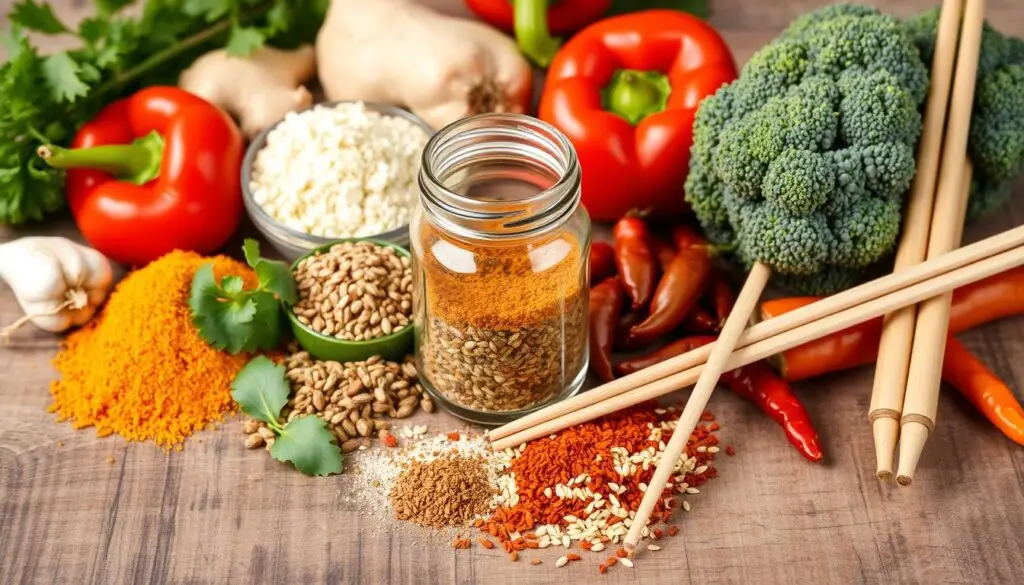
Key Takeaways
- You can make your own homemade stir fry seasoning using simple ingredients
- Good spices for stir fry like garlic and ginger are essential for a delicious flavor
- Stir fry spices can be customized to suit your taste preferences
- Homemade stir fry seasoning is a great way to add flavor to your meals without preservatives
- You can use your homemade stir fry seasoning to make a variety of dishes, from stir-fries to noodle dishes
Table of Contents
Essential Ingredients for Perfect Homemade Stir Fry Seasoning
Exploring homemade stir fry seasoning is exciting. We’ll look at the key ingredients that make it special. You’ll learn about cinnamon, cloves, ginger, and garlic. These are the chinese spices for stir fry that make dishes stand out.
To make your own stir fry seasoning, start with base spices and aromatics. Soy sauce, sesame oil, and five-spice powder are must-haves. They add depth and complexity to your seasoning.
Base Spices and Aromatics
- Ginger
- Garlic
- Soy sauce
- Sesame oil
- Five-spice powder
By mixing these ingredients right, you’ll get a blend that enhances stir fry dishes. Whether you use ground or whole spices, aim for a flavor balance. This will make your seasoning unforgettable.
Step-by-Step Guide to Mixing Your Signature Blend
Now, let’s dive into making your own stir fry seasoning. We’ll use a simple stir fry seasoning mix recipe that you can tweak to your liking. This recipe works for anyone who likes spicy, savory, or sweet flavors.
When mixing your seasoning, balance is key. You want to enhance the taste of your vegetable stir fry, including bell peppers, without overwhelming them. Here are some tips:
- Begin with common spices like garlic, ginger, and onion powder.
- Include a mix of sweet and savory elements, such as sugar, salt, and soy sauce.
- Play with heat levels by adding spices like cayenne pepper or red pepper flakes.
Remember, the secret to a great stir fry seasoning mix recipe is finding the right balance. Taste and adjust as you mix, adding more of certain ingredients until it’s just right. And don’t forget to add bell peppers for a sweet, crunchy touch!
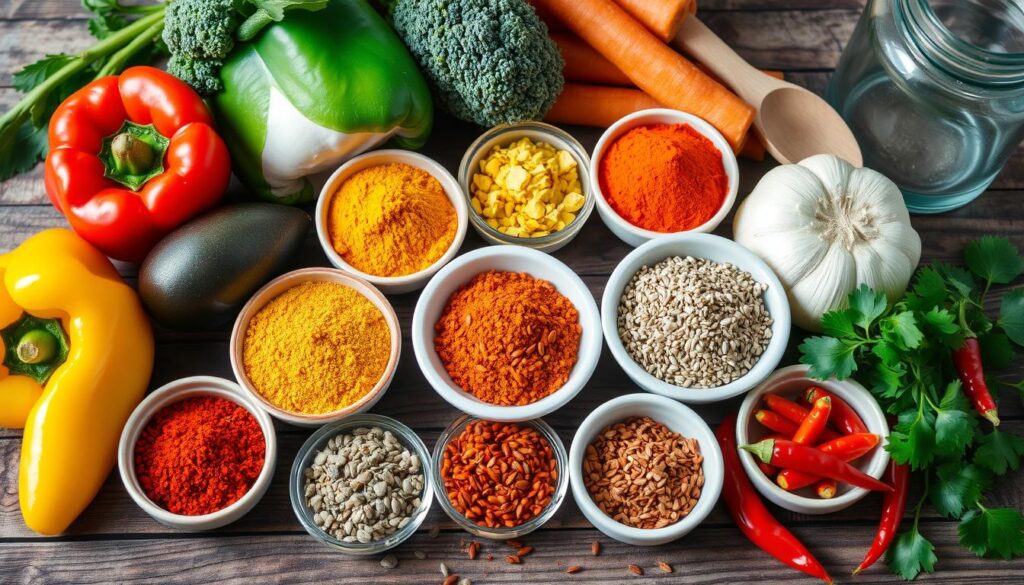
With these tips, you’ll soon be making your own stir fry seasoning blends. Enjoy experimenting and happy cooking! If you have any questions or need help, just ask.
| Ingredient | Quantity | Notes |
|---|---|---|
| Garlic powder | 2 tablespoons | Adjust to taste |
| Ginger powder | 1 tablespoon | Optional, but recommended |
| Sugar | 1 teaspoon | Balance out the savory flavors |
Making the Most of Your Stir Fry Seasoning Mix
Now that you’ve made your stir fry seasoning blend, it’s time to use it! I’m excited to share my top tips for using your seasoning mix. From how to store it to measuring for different dishes, I’ll cover the basics. This will help keep your seasoning fresh and flavorful.
When cooking with your stir fry seasoning mix, use medium high heat for the best flavors. Add a tablespoon of sesame oil to your wok or skillet for a rich taste. For a classic chinese stir fried dish, add your favorite stir fry vegetables like broccoli, carrots, and snow peas. Cook until they’re tender but crisp.
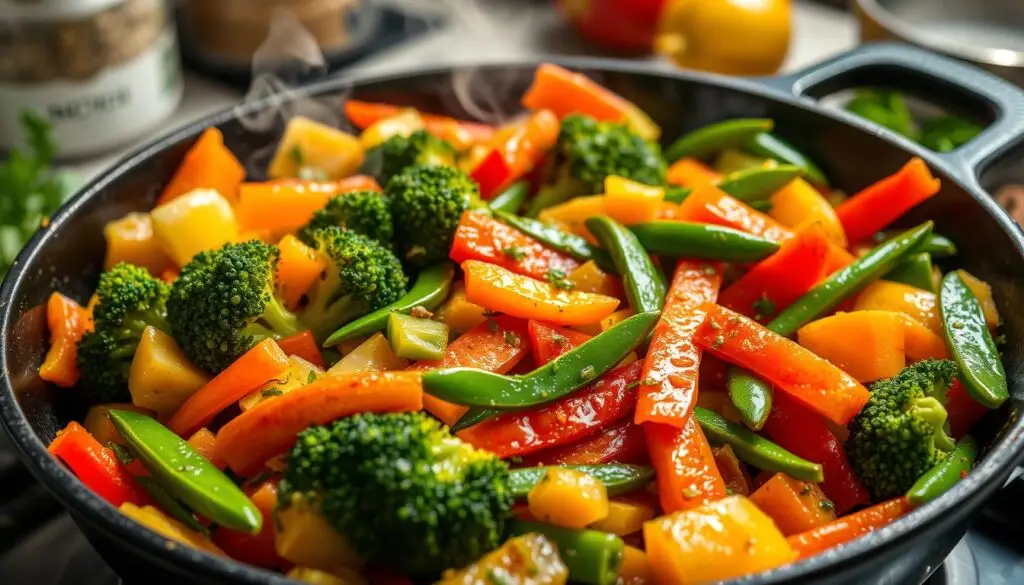
To get the most out of your stir fry seasoning mix, store it in an airtight container in a cool, dry place. Start with a small amount of seasoning and adjust to taste. You can also try different stir fry vegetables to find your favorite.
Best Practices for Stir Fry Cooking
- Use a wok or large skillet with a non-stick surface to prevent food from sticking and to make cleanup easier.
- Add aromatics like garlic and ginger to your dish for extra flavor.
- Don’t overcrowd your wok or skillet – cook in batches if necessary, to ensure that your food is cooked evenly and quickly.
By following these tips and experimenting with different ingredients and techniques, you’ll be well on your way to creating delicious and authentic chinese stir fried dishes with your homemade stir fry seasoning mix.
Creative Variations for Different Asian Cuisines
Exploring stir fry recipes opens up a world of flavors. Each Asian cuisine has its own taste. You can try Szechuan pepper for a spicy kick or Korean chili flakes for a nutty taste. It’s fun to mix different ingredients to make dishes that feel like they’re from Asia.
1. Spicy Szechuan Style
To make a Spicy Szechuan Style stir fry, use rice vinegar, gluten-free soy sauce, and Szechuan pepper. This mix is great for cooking bok choy and other Chinese veggies. Here’s what you need:
- Rice vinegar
- Gluten-free soy sauce
- Szechuan pepper
- Bok choy
2. Korean-Inspired Blend
For a Korean-Inspired Blend, mix Korean chili flakes, garlic, and ginger. This is perfect for beef or pork stir fries. Don’t forget to add rice vinegar to balance the taste.
3. Thai Flavor Profile
Thai cuisine is famous for its bold flavors. To get a Thai taste, combine fish sauce, lime juice, and Thai basil. This mix is great for chicken or shrimp stir fries. Make sure to use gluten-free ingredients for everyone to enjoy.
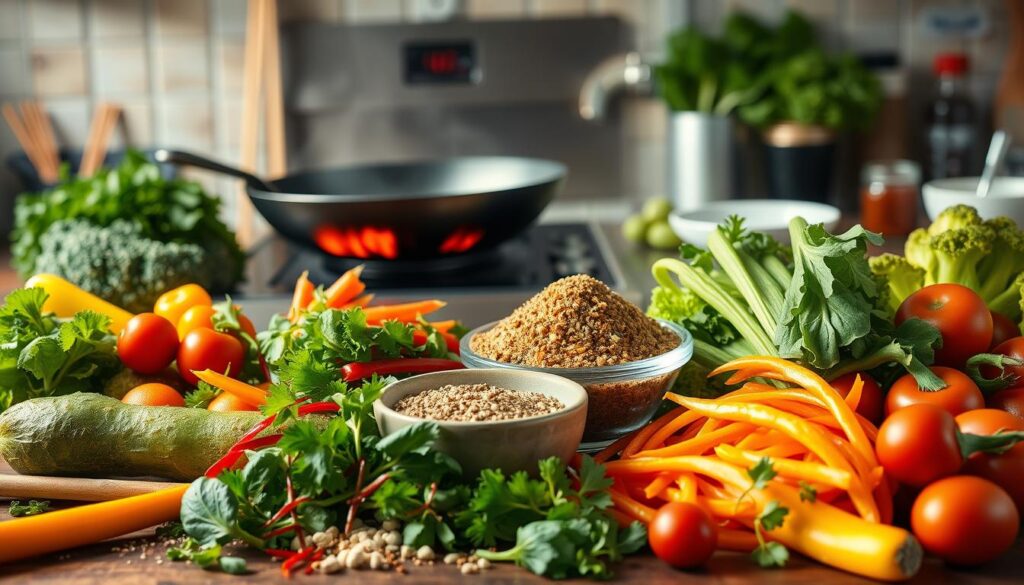
Conclusion: Mastering Your Homemade Stir Fry Seasoning Journey
As we reach the end of our journey, I’m confident you’ve mastered the art of crafting an irresistible homemade stir fry seasoning. This seasoning will elevate your meals to new heights. You’ve learned to balance aromatic spices and understand Chinese flavor profiles.
You’re now equipped with the knowledge and skills to create your signature blend. This blend will impress family and friends alike.
One of the best ways to use your fry seasoning is in meal prep. Whether it’s a quick stir fry or sautéed snow peas in Chinese stir fry sauce, your seasoning is the secret ingredient. With our handy recipe card, you can keep your go-to blend close at hand. This ensures consistent flavor in every dish.
As you continue your culinary journey, I encourage you to experiment with different variations of your stir fry seasoning. Try adding a touch of brown sugar for sweetness or bold Szechuan-inspired spices. The possibilities are endless, and I’m excited to see what you’ll create in your kitchen.
FAQ
What are the essential ingredients for a homemade stir fry seasoning?
To make homemade stir fry seasoning, you need base spices and aromatics. These include garlic, ginger, cumin, and chili powder. You can also add flavor enhancers like sesame seeds, rice vinegar, and brown sugar.
How do I create my own signature stir fry seasoning blend?
To make your own stir fry seasoning, follow a step-by-step guide. Mix and match the essential ingredients to match your taste. Experiment with different amounts of spices, aromatics, and enhancers to find the perfect flavor.
What are the best storage methods for homemade stir fry seasoning?
Store your homemade stir fry seasoning in an airtight container in a cool, dry place. Keep it away from direct sunlight and heat. This helps keep the spices fresh and flavorful.
What are some creative variations for different Asian cuisines?
You can make different stir fry seasoning blends for various Asian cuisines. Try a spicy Szechuan-style blend or a Korean-inspired blend with gochugaru. You can also make a Thai-inspired blend with lemongrass and kaffir lime leaves.
How much stir fry seasoning should I use for different dishes?
The amount of seasoning you use depends on the dish size and your taste. Start with 1-2 tablespoons per pound of protein or vegetables. Adjust to your liking for flavor.
What are the best vegetables to use for a seasoned stir fry?
Great vegetables for seasoned stir fries include bell peppers, broccoli, carrots, snow peas, and bok choy. These veggies are tender-crisp and hold up well to bold flavors.
